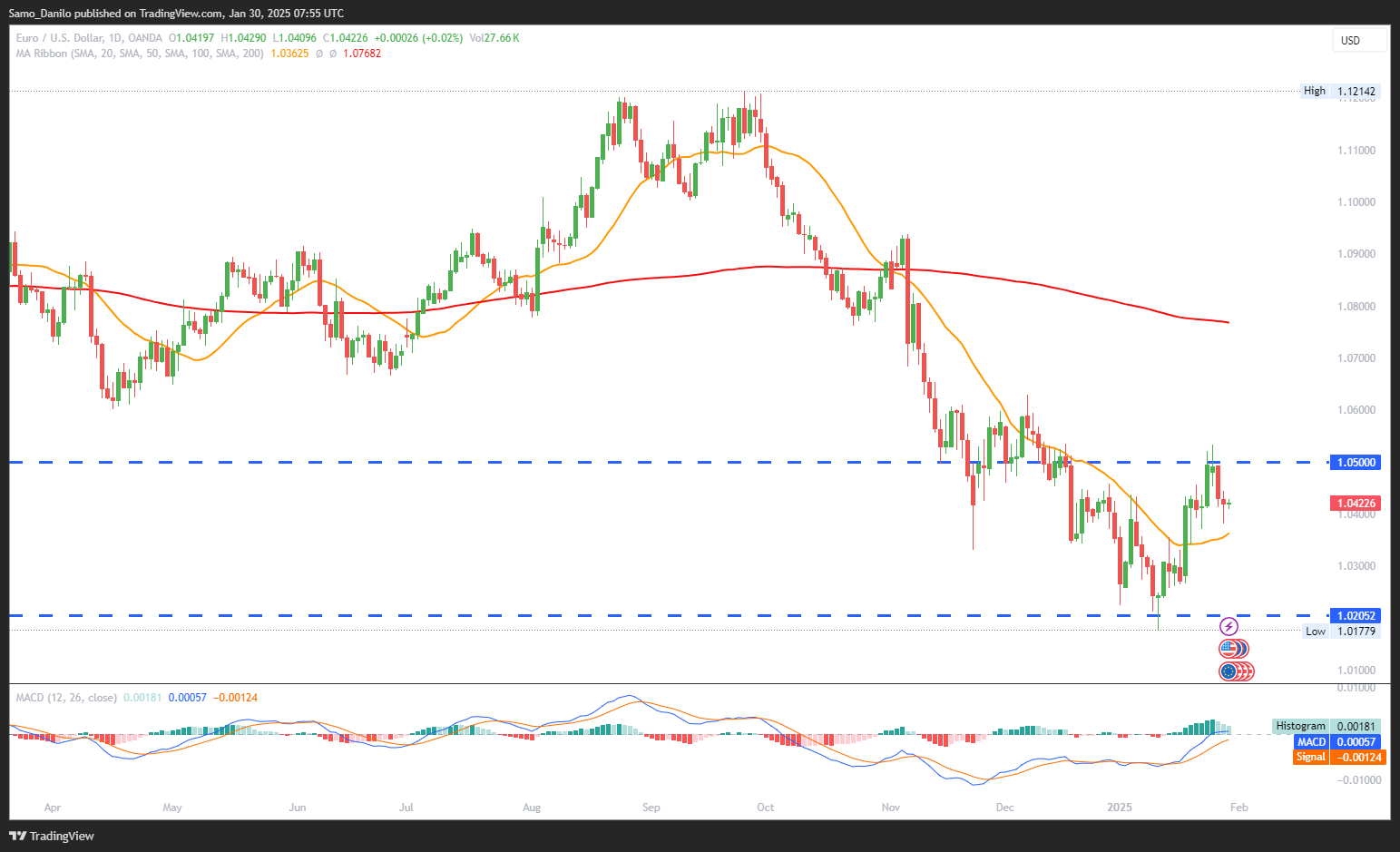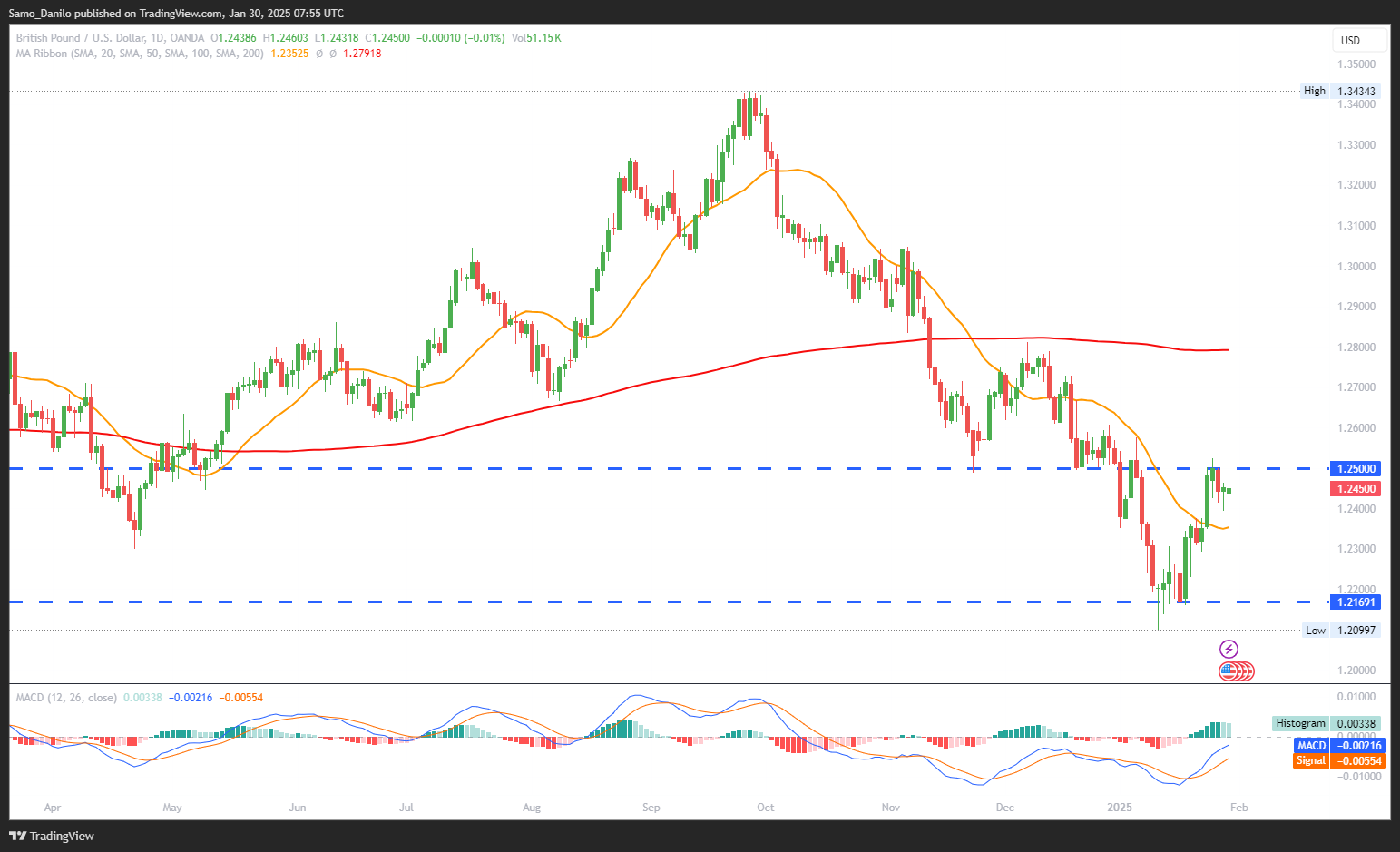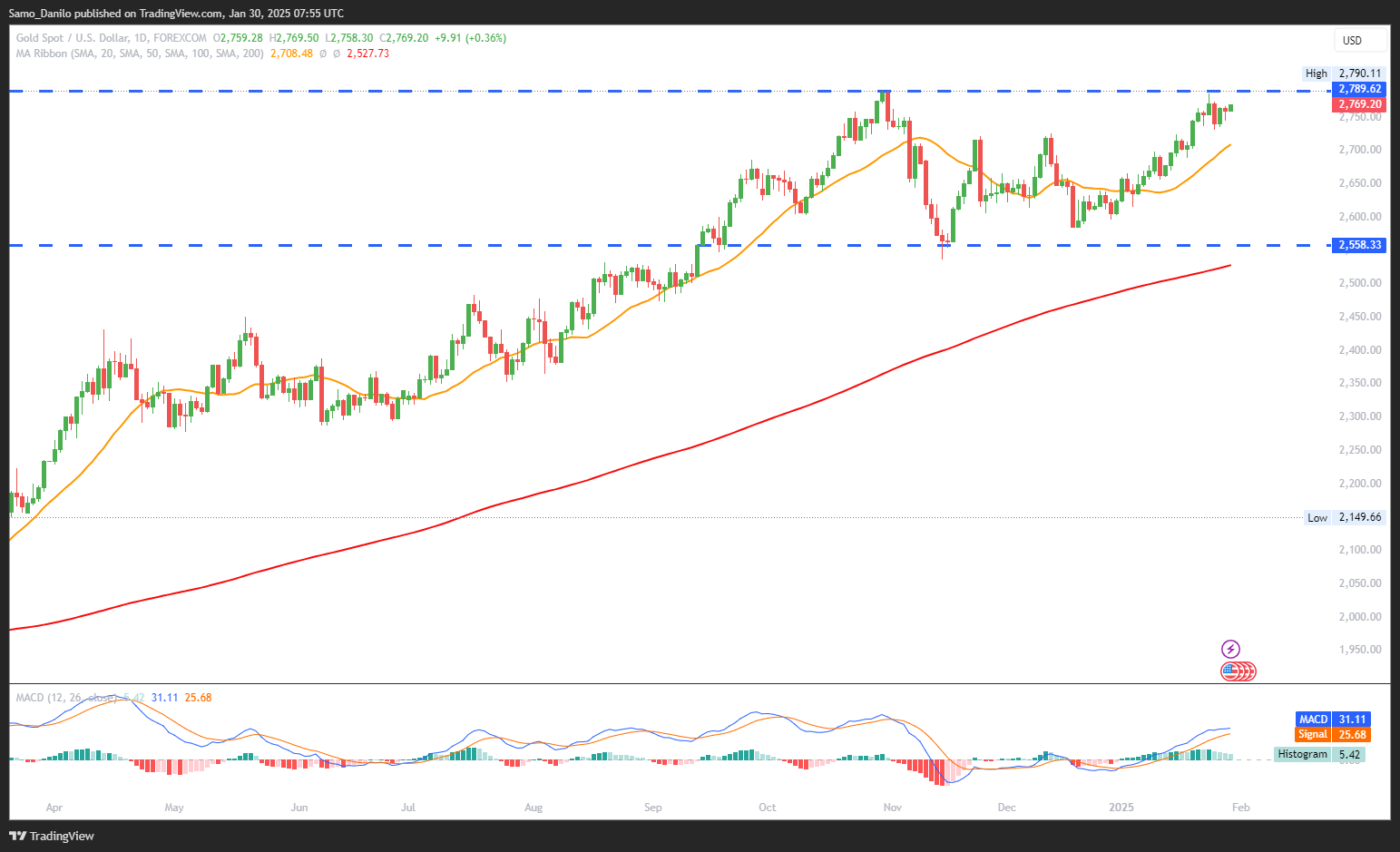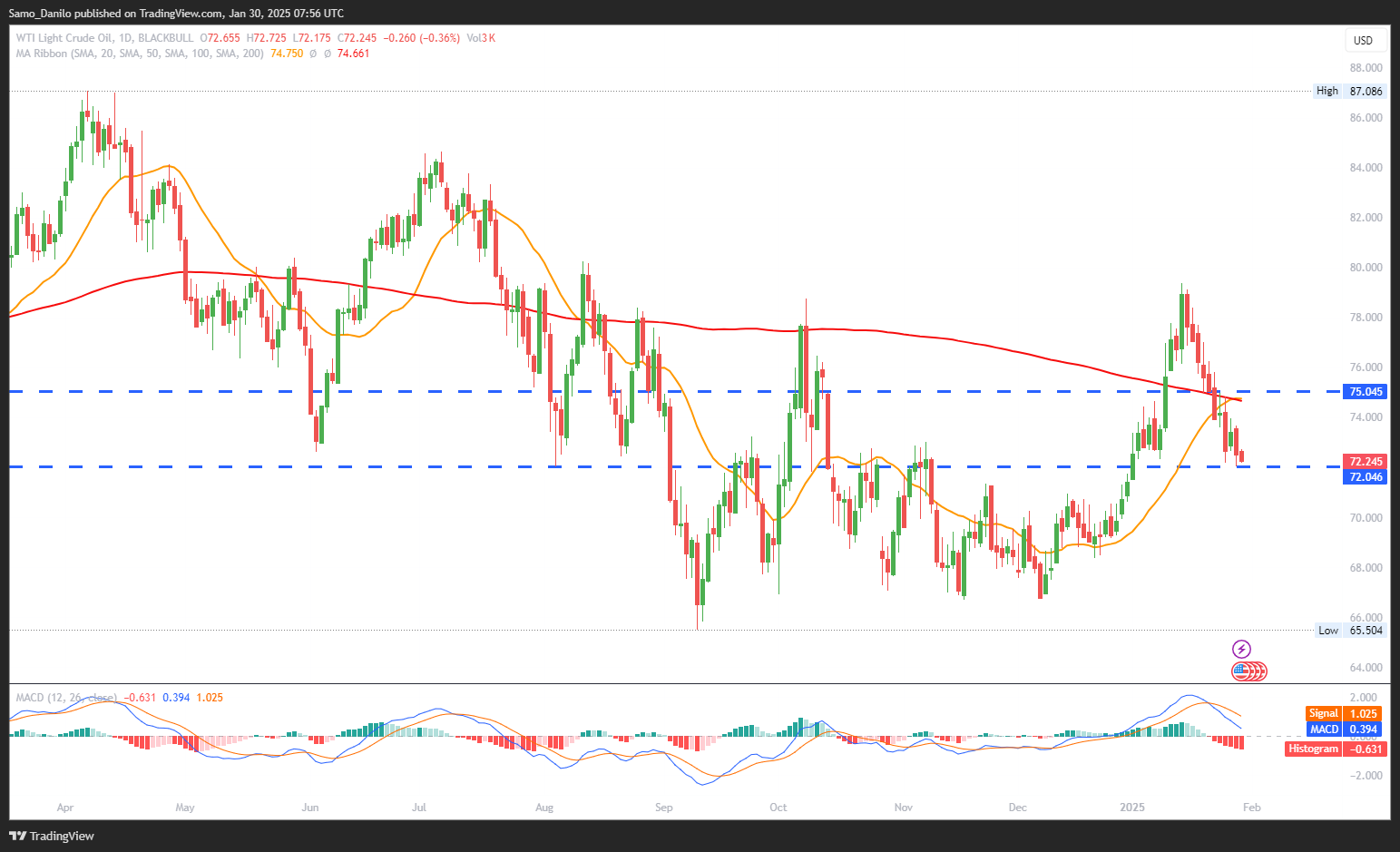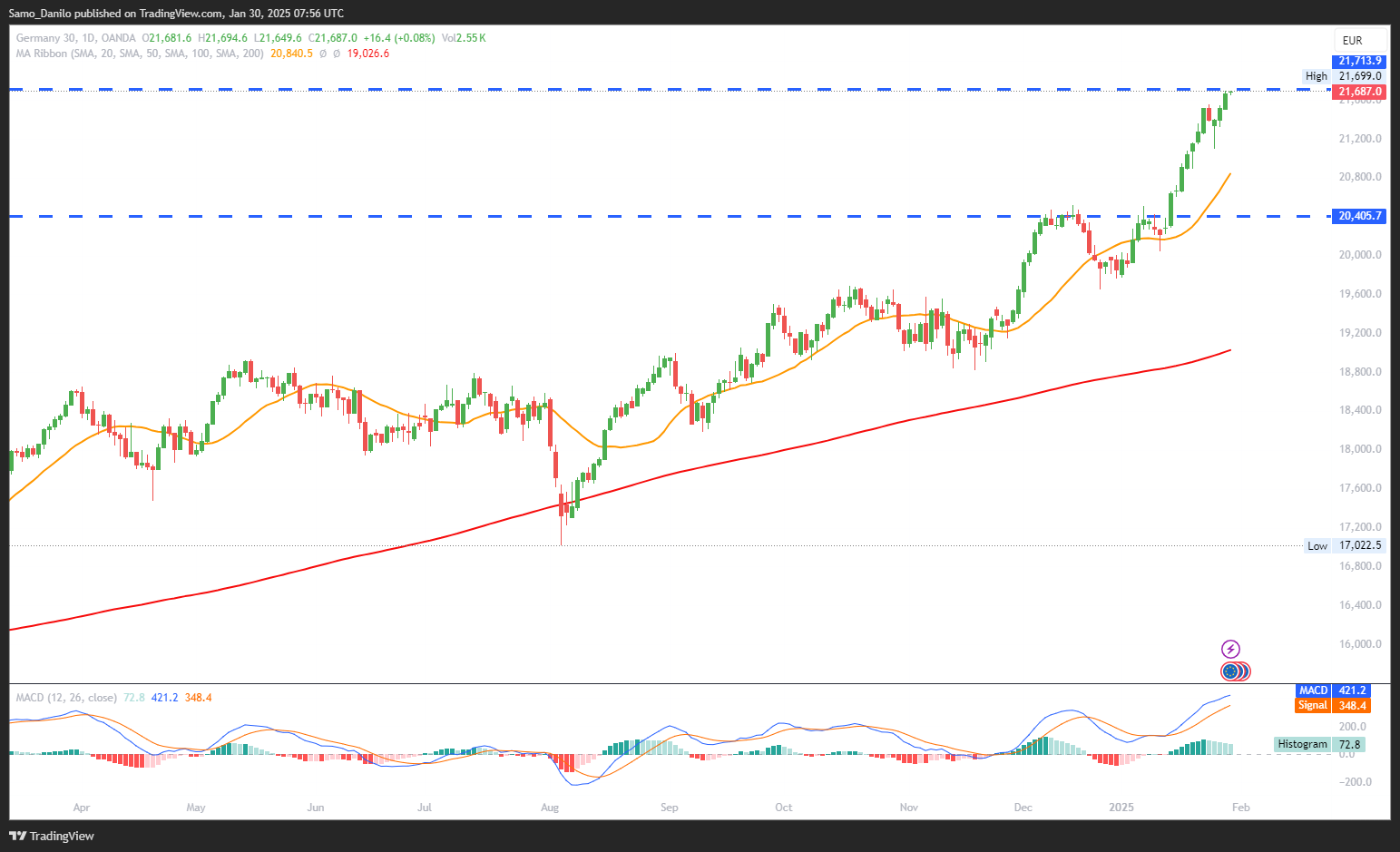EURUSD
- EUR/USD Price: The EUR/USD pair is sliding toward 1.0400 in Thursday’s European session as the US Dollar Index (DXY) remains firm, trading just below 108.00. The greenback continues to find support from the Federal Reserve’s latest policy stance.
- Fed Rates: As widely expected, the Federal Reserve maintained its interest rate at 4.25%-4.50% during its January meeting. However, the central bank reinforced a hawkish outlook by removing previous language that expressed confidence in inflation reaching its 2% target.
- Powell Signals: In his post-meeting press conference, Fed Chair Jerome Powell stated that the Fed needs to see "real progress on inflation or some weakness in the labor market" before considering any policy adjustments. This stance has bolstered USD strength and weighed on EUR/USD.
- ECB Rates: The Euro remains under pressure as the European Central Bank (ECB) is expected to lower its Deposit Rate by 25 basis points to 2.75% at its policy meeting on Thursday. A confirmed rate cut could further weaken the EUR against the USD.
- GDP Report: Traders will closely monitor the release of fourth-quarter GDP data from the Eurozone and Germany on Thursday. Additionally, attention will shift to the US Gross Domestic Product (GDP) Annualized report, which could provide further direction for EUR/USD.
Closing statement: EUR/USD remains on a downward trajectory as the Fed’s hawkish stance supports the US Dollar, while expectations of an ECB rate cut add to the Euro’s weakness. Market participants will look to upcoming GDP releases for further insights into economic growth and monetary policy trends.
GBPUSD
- GBP/USD Price: The GBP/USD pair remains under pressure in Thursday’s early European session, trading below 1.2450. Renewed demand for the US Dollar, coupled with a risk-off sentiment, continues to weigh on the pair.
- Technical Outlook: On the daily chart, GBP/USD maintains a bearish bias, staying below the key 100-day Exponential Moving Average (EMA). However, the 14-day Relative Strength Index (RSI) hovers near the midline, suggesting possible consolidation before further directional movement.
- Fed Rates: As expected, the Federal Reserve kept interest rates unchanged during its January meeting. Fed Chair Jerome Powell reiterated that future rate decisions will be guided by incoming economic data, reinforcing the central bank’s cautious approach.
- Powell Remarks: Powell also acknowledged that the Fed is monitoring policy developments under newly-inaugurated President Donald Trump but stated that there has been no direct communication between the administration and the central bank regarding monetary policy.
- US Q4 GDP: Traders will closely watch the upcoming release of US fourth-quarter GDP data on Thursday. Market forecasts suggest a slowdown in annualized GDP growth, with expectations at 2.6%, down from the previous 3.1%. A weaker-than-expected reading could influence Fed rate expectations and impact USD strength.
Closing statement: GBP/USD remains in a bearish phase as USD strength and market caution limit upside potential. Traders will look to the US GDP data release for further direction, with any deviations from expectations potentially driving short-term volatility in the pair.
XAUUSD
- Gold Price: Gold prices continue to consolidate within their weekly trading range on Thursday. A subdued US Dollar performance in Asian trading has provided some support to gold buyers, though broader market uncertainty keeps gains in check.
- Fed Rates: As widely expected, the Federal Reserve held its benchmark policy rate steady within the 4.25%-4.50% target range. However, subtle changes in the policy statement leaned toward a more hawkish stance, signaling a cautious approach to future rate cuts.
- Rate Cut Expectations: Market expectations for Fed rate cuts in 2025 have moderated. Traders are now pricing in around 46 basis points (bps) of cuts by year-end, compared to 48 bps before the Fed’s statement. This slight shift reflects reduced confidence in two full rate cuts this year.
- US Tech Earnings: Market sentiment remains cautious following earnings reports from major US tech firms. Meta reported a strong Q4 performance with a 21% revenue increase, while Microsoft disappointed with weak revenue guidance. Tesla’s shares rallied despite missing expectations on both revenue and profit. These mixed results have kept investors on edge.
- Geopolitical Risks and Data: Concerns over slowing US economic growth and renewed trade war fears under President Donald Trump’s administration continue to bolster gold’s appeal as a safe-haven asset. Investors will now focus on upcoming US data releases, including weekly Jobless Claims and the quarterly PCE Prices report, for further market direction.
Closing statement: Gold remains supported by a weaker USD and risk aversion amid geopolitical uncertainties. However, shifting Fed rate cut expectations and upcoming US economic data could drive further volatility in the near term.
CRUDE OIL
- WTI Oil Prices: West Texas Intermediate (WTI), the US crude oil benchmark, remains around $72.60 in the late American session on Wednesday. Persistent supply-side pressures and macroeconomic uncertainty continue to weigh on price momentum.
- US Crude Inventories: The latest Energy Information Administration (EIA) data revealed a 3.463-million-barrel increase in US crude stockpiles for the week ending January 24. This larger-than-expected build suggests weakening demand, putting downward pressure on oil prices.
- Trump’s Tariff Plans: The White House reaffirmed that President Donald Trump intends to impose 25% tariffs on imports from Canada and Mexico starting February 1. These tariff threats could disrupt crude oil flows in North America, further complicating the supply-demand outlook.
- Fed Rates: As expected, the Federal Reserve kept its benchmark rate unchanged at its January meeting. However, Fed officials provided little clarity on when rate cuts might begin. This uncertainty strengthened the US Dollar, which in turn pressured oil prices, as a stronger USD makes commodities more expensive for international buyers.
- Economic Data: Oil traders will closely watch the upcoming US Q4 Gross Domestic Product (GDP) release, as well as weekly Initial Jobless Claims and Pending Home Sales data. These indicators will provide further insight into US economic health and potential demand trends for crude oil.
Closing statement: WTI remains under pressure due to rising US crude inventories, Trump’s trade policies, and a stronger USD. Near-term price action will likely depend on upcoming US economic data and further developments in global trade policies.
DAX
- DAX ATH: The DAX 40 index continues its upward trajectory, defying concerns over Germany’s struggling economy and volatility in the tech sector. The index's diverse composition and international exposure have helped it remain resilient amid market fluctuations.
- Key Stocks: SAP, Siemens, and Deutsche Telekom—three of the most heavily weighted stocks in the DAX—were among the top gainers. Given their significant influence, their positive performance has played a crucial role in driving the index higher.
- Import Prices: German import prices rose 2.0% in December 2024 compared to the previous year, marking a steady increase from November’s 0.6% gain and a reversal from October’s -0.8% decline. This signals growing price pressures, which could influence inflation expectations.
- ECB Rates: The European Central Bank (ECB) is widely anticipated to lower its key interest rate by 25 basis points to 2.75% in its January meeting. Policymakers are expected to maintain a dovish stance, leaving room for additional rate cuts as economic uncertainty persists.
- GDP Data: Traders are closely watching the release of Q4 GDP data from both the Eurozone and Germany on Thursday. Later in the session, the US Gross Domestic Product Annualized report will provide further insight into global economic conditions and market sentiment.
Closing statement: The DAX remains strong despite economic challenges, driven by major stock gains and international market exposure. The ECB’s rate decision and upcoming GDP data will be key catalysts for the index’s next move.
